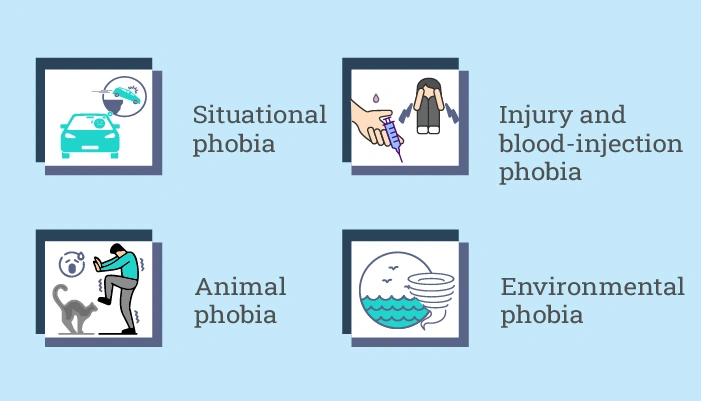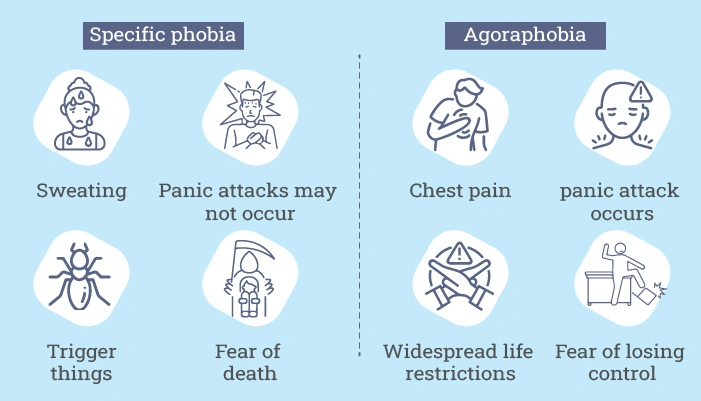Agoraphobia and specific phobias are both distinct types of anxiety, caused by intense, persistent fear and avoidance of specific situations. But they both have different situations of fear and differences in symptoms.
In this article, we will explore how specific phobia and agoraphobia are different, their symptoms, prevalence, causes, and what treatment options are available to treat agoraphobia and specific phobias.
What is a Specific Phobia?
Specific phobias are previously known as simple phobias and cause extreme fear, anxiety, or nervousness from a specific thing or object. This irrational fear of a specific thing causes the individual to avoid the situation immediately. These phobias cause issues in daily life activities, such as school, relationships, and work.
Types of Specific Phobia
There are different types of specific phobias.
These include:
- Situational phobia
- Animal phobia
- Injury and blood-injection phobia
- Environmental phobia

What is Agrophobia?
Agoraphobia is a complex mental health situation in which individuals avoid going out and situations where they fear may be triggered. They have an excessive fear that they might be trapped in a situation where no one can help them. It impacts daily life activities, work, and relationships.
Differences In Symptoms
Specific phobias and agoraphobia are two distinct disorders; they have differences in symptoms.
These include:
| Specific phobia | Agoraphobia |
| Nausea, sweating, and shaking. | Chest pain, shortness of breath. |
| Panic attacks may not occur. | A panic attack occurs. |
| It is triggered by specific things such as animals, insects. | It occurs in multiple situations. |
| It is usually limited to things involving the phobia. | It can cause severe, widespread life restrictions. |
| Fear of injury or death. | Fear of losing control or panic in public. |
| Avoid only specific situations. | Avoid multiple environments. |

What are the causes of agoraphobia and specific phobia?
The exact causes of agrophobia and specific phobia are still unidentified, but they can be caused by the following:
| Causes of specific phobia | Causes of agoraphobia |
| It can be caused by a tragic event in the past or by hearing about it. | It can be caused by traumatic events. |
| It can be inherited. | It can be caused by family history. |
| It can be caused by differences in brain functionality. | It can be caused due to changes in brain chemicals, such as neurotransmitters. |
| It can be triggered by excessive use of substances. | It can be triggered by stressful events. |
What Is the Prevalence and Onset Age of Agoraphobia And Specific phobia?
| Specific phobia | Agoraphobia | |
| Prevalence | Around 3 to 15% of people around the world suffer from specific phobias. | 1.2% of people experience agoraphobia worldwide at some time in their lives. |
| Onset age | It occurs in childhood or early teens. | It arises in late teens or early adulthood. |
How to Diagnose Specific Phobia And Agoraphobia?
Specific phobia and agoraphobia both can be diagnosed by a healthcare provider using the Diagnostic and Statistical Manual, 5th edition (DSM-5). There are no significant blood tests available for the diagnosis; the healthcare professional diagnoses it through symptoms and severity, and previous medical history.
Healthcare providers may ask the following questions for the diagnosis.
These include:
- Do you avoid going out?
- Are you afraid of situations and places?
- Is there any specific situation or thing you are afraid of?
Treatment of Agoraphobia and Specific Phobia
The symptoms of agoraphobia and specific phobia can be reduced with the right medications and therapies.
1. Medications
Medications are very helpful for reducing the symptoms of both specific phobia and agoraphobia.
- For reducing the symptoms of agoraphobia, healthcare providers recommend SSRIs and benzodiazepines.
- For specific phobias, professionals may be advised to take Benzodiazepines to reduce anxiety.
2. Therapies
2.1. Cognitive Behavioral Therapy:
Cognitive behavioral therapy is the ideal technique to treat specific phobias and agoraphobia. CBT helps individuals cope with challenges by reducing negative thoughts and helps them overcome their fears. Furthermore, individuals with specific phobias have a fear of specific things or animals. CBT helps them cope with this fear.
On the other hand, CBT helps individuals suffering from agoraphobia challenge their fears, for example, they have a fear of crowded places and think that if they get a panic attack, they will lose control or get embarrassed. CBT helps them to challenge these fears to cope with them.
2.2. Exposure Therapy
This therapy is very helpful for people who are experiencing specific phobia or agoraphobia, as in this therapy, healthcare professionals expose the individual to the feared situation so that they can overcome it.
Furthermore, exposure therapy can be done in virtual reality or in real-life situations.
Lifestyle Changes
Following a healthy lifestyle can reduce the symptoms of specific phobia and agoraphobia
These include:
- Regular exercise
- Healthy diet
- Avoiding substances and caffeine
Other Considerations
- Connect with support groups, so you can meet individuals who are suffering from the same situations to get motivation and encouragement to cope with these disorders.
- Learn how to manage stress by doing meditation and deep breathing to reduce anxiety.
Begin Your Healing at Renewed Mental Health Group
Are you or any of your loved ones struggling with mental health conditions? Are you looking for a reliable platform where you can get mental health treatments? At Renewed Mental Health Group, we have a team of experts who provide the best mental health services, including agoraphobia and specific phobias, etc. Our professional experts perform a complete evaluation and then recommend a treatment plan according to your severity and symptoms.
Your mental health is important!
Book your initial consultation today.
Last Remarks
Agoraphobia and specific phobia are both distinct mental health conditions, with differences in symptoms. Individuals having a fear of heights, animals, or any specific things are known as simple phobias. Whereas agoraphobic individuals have extreme fear of going out, leaving home, etc. Both conditions are more common in females and can be caused by various reasons.
Exposure therapy and CBT are very helpful for individuals with specific phobias and agoraphobia.

